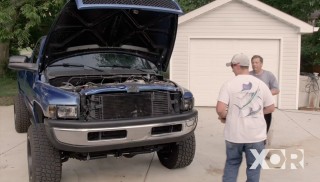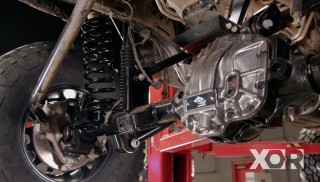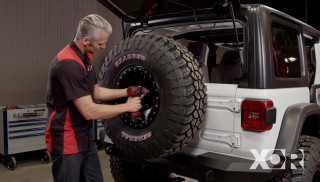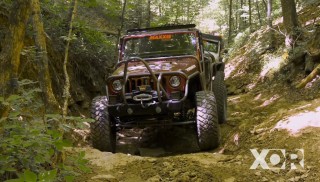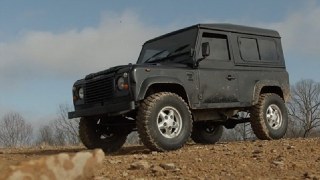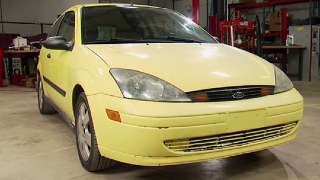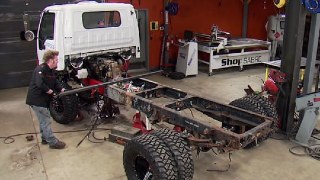XOR - Xtreme Off-Road Builds
Want more content like this?
Join the PowerNation Email NewsletterParts Used In This Episode
American Force
BL1 Dune Beadlock
Lincoln Electric
Lincoln Electric is the official welding supplier to XOR
Matco Tools
MATCO Tools are the Official Tool Supplier to XOR
The Industrial Depot
Tools, Hardware, and Shop Supplies
Episode Transcript
(Narrator)>> Today on XOR we start cutting, banging, and dismantling the front end of the Tacoma. Jeremy clears the way for a front axle swap while Eliza throws a set of performance brakes on the front end of the Pre-Runner Ranger. That's today on XOR.
♪ ♪
(Jeremy)>> Hey guys, welcome to XOR. Well today we're gonna switch things up and move away from our two wheel drive Pre-Runner Ranger on to our four wheel drive Toyota Tacoma. Now when we picked this truck up it sat pretty much the way it is. It's got a small little lift and these 32 inch tall tires. Well that's just not gonna cut it for us here in Xtreme Off Road. So they've got to go.
(Eliza)>> Remember when we picked up the truck and we talked about bigger tires? Well this is what we've got in mind, but in order to get these big tires on our truck we've got to make some room for a solid axle swap, and that begins with getting rid of all of that. [ drill spinning ]
(Jeremy)>> Well those haven't been off in a long time. Alright let's take the winch plate off. ♪ ♪ We're gonna win! Get off of there bumper. Holy smokes! ♪ ♪ With all the relatively easy stuff out of the way we're gonna get down to the nitty gritty. ♪ ♪ With the coil over out of the way we'll move on to the bearing nut. [ drill spinning ] ♪ ♪
(Jeremy)>> And we'll take the upper control arm free. ♪ ♪ [ ratchet spinning ] ♪ ♪
(Jeremy)>> And we'll loosen the tie rod end and the lower ball joint to get the spindle free. [ hammer tapping ] ♪ ♪
(Jeremy)>> Viola! And thanks to one of our biggest Matco Tool pry bars the c/v axle comes right out. And after the skid plate's gone we move on to the entire rack and pinion. ♪ ♪ I think that's released from the steering. [ drill spinning ]
(Jeremy)>> And the lower control arm comes free with a little persuasion. [ hammer banging ]
(Jeremy)>> Two can be as bad as one! ♪ ♪ This thing isn't gonna weigh anything when we're done. Now even if we weren't doing a solid axle swap it looks like we had to replace some parts anyways. Lower control arm bushing pretty much shot. Up next the driveshaft. Those haven't been out in a long time. And the old mechanic's rule. Whatever you drop will fall right into the drain pain. Two points! We've got to take the front driveshaft out to get rid of the front differential. We're gonna have custom drive shafts made for this truck anyways. So there's no point in saving them. [ drill spinning ] ♪ ♪ [ hammer tapping ]
(Jeremy)>> And of course up next is the front diff itself. ♪ ♪
(Jeremy)>> Woo!
(Narrator)>> Next Jeremy fires up the torch and grinder to put our Tacoma on a strict weight loss program.
(Jeremy)>> Hey guys welcome back to XOR and the IFS removal on our Toyota Tacoma, and that all gets started with a little bit of fire. And the first tool I reach for when I have to get rid of a bunch of metal is a good ole fashioned torch, and you guys probably already own one or at least your buddy does. We're starting with the easier of the three pieces that we're gonna be cutting off. This is just one of the lower control arm mounts. The heat of the torch and gravity will let you know when your pieces are just about ready to be set free. Here we go! Say goodbye to IFS. ♪ ♪ When using a torch to cut off pieces on the bottom of your vehicle it's good to have a start point and a stop point. Well on our cross member here we have a hole on this side and a hole on the other side. So I'm gonna use this as my starting point and cut around it to the back side where the hole is, and then when I get there I'll wrap from the hole on the back side, come around to the front, meet back at that hole, and we'll have a nice clean cut and I'll repeat it on the other side. Torch setup is key to a nice, clean cut. Make sure you let the metal heat up just a little bit before you start applying any oxygen. [ torch hissing ]
(Jeremy)>> With the proper setup you can get rid of metal pretty quickly. [ torch hissing ]
(Jeremy)>> When you're cutting big pieces off your truck pay attention to what's on the ground, especially the torch hoses cause you don't want this falling on and piercing your hose, and causing a really big fire. [ torch hissing ]
(Jeremy)>> That is one stinky, messy Tacoma. ♪ ♪ And one quick thing. Always pay attention to where you're cutting on your chassis when you're using your torch. And when you use your torch try not to face it directly at the chassis because you could cut into it and take the structural integrity away. Lay your torch down alongside of it and actually slice through the metal. Then you won't touch your chassis and everything ♪ will be nice and strong. ♪ ♪ ♪ Always pay attention to where your cutting, especially in the engine compartment cause you don't want to be throwing sparks at something really expensive or something that could well catch fire. [ torch hissing ] ♪ ♪
(Jeremy)>> Now the question is if you did a good enough job how many swings is it gonna take? One, or two, or three, or one? Perfect! We're using an electric four inch grinder with a flap disc to smooth up our chassis, and this is the perfect example. When you cut really close to the chassis with the torch it leaves very little to clean up. Now you guys are probably wondering why in the world did we cut the entire front suspension off of our Tacoma? Well this is gonna be more of a designated trail rig. It's not gonna see that much time on the street. So we're gonna be doing a solid axle swap and getting rid of the independent front suspension. Well there's two big difference between the two, and let me show you what they are. Now you're probably wondering why in the world would we go through all this work? Well a solid axle is like a straight beam underneath your truck. As one side goes up over an obstacle that drives the other side down. That keeps both tires in traction, and that'll work great for Eliza and myself when we're in the Tacoma out on the trails. The simplicity, the durability, and the functionality of these solid axles is why it's found under a lot of the rigs out there. And for us and our rig this is the most efficient and cost effective way to get as much flex out of our suspension, but there's nothing wrong with independent front suspension, or IFS. Now if our rig was gonna spend more time on the highway then off road the IFS would be just fine, but for us a solid axle it is. Now I modified the bar to show you guys how independent front suspension works. Both ends move completely independent from one another versus a solid axle where the whole thing moves as one piece. Sometimes this system is not ideal. [ engine revving ]
(Jeremy)>> Each system definitely has its place, but for sheer simplicity we're going with a solid axle setup underneath our Tacoma. To settle the argument between IFS and a solid axle. There's just a whole bunch of moving parts and serviceable parts sitting here on the pallet, versus the pure simplicity of a solid axle. And when it comes down to it pick the system that best works for you. And for us and our Tacoma we're going with a solid axle but we're not done there. We've still got all the suspension to worry about, all the steering, the brakes, the drive shafts, and we've got to match gears front and rear. So we definitely got a lot of work to do.
(Narrator)>> Up next Eliza tackles the Pre-Runner Ranger. It's brake time on XOR!
(Eliza)>> Hey guys, welcome back to XOR. We're gonna give our poor little Toyota a break while we put some brakes on this one, but since we've got so much suspension travel we're gonna have to take some special considerations. We welded on LSK's caliper bracket that matches the brake setup we chose to run on our pre-runner. And as always we are using grade eight bolts to hold her in. [ ratchet twisting ]
(Eliza)>> Usually brake lines are made of rubber hose, and for everyday driving that's just fine but not for us. We're going with a stainless steel braided line that has a Teflon inner tube. These will not expand under pressure or high temperature, and the stainless steel outer makes them resistant to punctures and tears. Okay so here are our special accommodations. We've got 19 inches of wheel travel. So what we did is we took 42 inches of brake hose so that we can run it along our lower control arm. So that way all we have to worry about is about four inches of movement before it gets to our hard line, as opposed to 19 plus of movement here, and we're gonna do that by drilling, tapping, and using some hose clamps.
Obviously the best place for our brake line is gonna be behind our monstrous control arm. Now these arms are heavy duty and thick. I am making a pilot hole so I can come back with the correct size bit for a clean tap.
There's a variety of clips, clamps, and retainers that you can choose from to secure your brake lines. It's a small detail that can make for a very clean and useful install. While we're doing this let me show you how we selected the correct tap for our project. The first step is identifying the fastener that you will be using for your project. This is ours. Then you take your TPI gauge, or your threads per inch gauge, and measure the threads per inch on your fastener. Our fastener here has 24 threads per inch. That makes this a 10-24. Then identify your 10-24 tap and assemble it onto your wrench. Then you come over to your tap drill selector. Scroll down until you get to 10-24. Move over to the drill bit size and you have size 22 drill bit. 22 bit, right size tap, and we are ready to drill. [ drill spinning ]
(Eliza)>> When using the tap the best advice I can give you is take your time. Use the old rule of one turn clockwise. Then back it out counterclockwise to clean out the metal shavings. Repeat this process until you have reached the depth that you need for your fastener. One of my favorite tools in the shop is this automatic center punch. I use it to keep the drill bit from walking, especially on hard surfaces like this. It makes for a clean looking install. ♪ ♪ With our brake lines in place we can connect it to our hard line that runs along the frame. ♪ ♪ Alright, all we've got to do is cycle our suspension and make sure everything's okay. So we have all of our brake lines installed, and now we need to get our proportioning valve in. Now we want our truck to squat and not dive. So we're gonna go ahead and get our brakes adjusted to where the rear brakes are engaging first but our front brakes are pulling most of the load. And to achieve that we're gonna get our proportioning valve installed between our master cylinder and our rear brakes. ♪ ♪ The proportioning valve installs onto the master cylinder and is connected to the fitting that feeds pressure to the rear brake line. The rear hog line is then fitted to the line running out of the proportioning valve, giving you control over the pressure feed to your rear brakes. ♪ ♪
(Narrator)>> When we come back the new 35's get sandwiched between aluminum bead locks on the pre-runner, stick around!
(Eliza)>> Hey guys, welcome back to XOR. Today we are finally gonna get some new shoes onto our Pre-Runner Ranger, and we have chosen to go with General Grabber's XThree. Now the Grabber XThree is General's mud terrain, and they have a very aggressive tread that will help us navigate any terrain we want to take on. We're wrapping our Grabbers around American Force Wheels aluminum forged 17 inch bead locks.
(Jeremy)>> Best thing about bead lock wheels is you don't even have to take them to a shop to have the tires put on them. You can do them at home in your garage. They just need a little persuasion. Woo hoo!
(Eliza)>> With your bead locks comes a bolt kit, and in that bolt kit there are two extended bolts that help you start and seat your bead lock ring. ♪ ♪ Now once your ring is far down enough you can get the other bolts started. I use a crisscross pattern. This ensures that I'm putting even pressure on the bead lock ring, and will prevent some balancing issues, and always torque to bead lock specs.
(Jeremy)>> We ordered extra-long lug nuts to go with our extra-long wheel studs on our axle, and we got our lug nuts from Summit Racing dot com.
(Eliza)>> Not only is this wheel and tire combo trail rated, it adds the right amount of bling to our build. [ drill spinning ] ♪ ♪
(Jeremy)>> Oh, these are heavy! Add a lot of weight to the back though. ♪ ♪ There's two! ♪ ♪
(Eliza)>> Now I've spent countless hours in the desert wrenching on bad boys like this one. I'm really proud at how it's coming together and I know it's gonna be a monster out on the race course.
(Jeremy)>> From the original design of this truck on a piece of scratch paper I am pleased at the way that it is turning out, and together we've both got about 600 hours into the build so far.
(Eliza)>> For more information about anything you've seen on today's show visit us at Powernation TV dot com. Our Ranger has come a long way from when we first drove it into the shop. It's finally sitting on its own weight. Suspension work is almost done. Cage work is almost complete, but we've got to go through it with a fine tooth comb.
(Jeremy)>> And while we're doing that we're gonna take the front clip off of the truck because, well we've got to paint it anyways. We'll also be putting the engine and transmission back in this truck, and that's gonna give us a true four corner weight, and then from there we'll start dialing in our suspension. ♪ ♪
(Jeremy)>> Well here in the shop we do an awful lot of building on our big projects, and we do something that we call mock up work. That's where you just kinda get a game plan and a design to see if you like how it's gonna look. Well today we're gonna be mocking up a front bumper on our pre-runner. We're also gonna be looking at two different styles of headlights to see if we like them and make sure they work perfectly on the pre-runner. Now a lot of you guys out there don't have a bender but here's a little tip. You can go to any home improvement store and pick up electrical conduit. It's super cheap and it's super thin so you can easily bend it over your knee to get your final design. We're using inch and three quarter tubing like we did on the rest of the Ranger and the dyes to match. After each pass we just have to tighten the top dye down to increase the radius. We're gonna slowly approach the radius and take our time. That way we won't over bend the piece and have to start all over again. ♪ ♪ Now that we have the basic shape, or the mock up, done of the bumper we've got to see how it fits the truck. [ metal clanging ]
(Jeremy)>> Now one of the best tools you can have in your shop for mock up purposes is a set of jack stands for three reasons. One you probably already own a set. Two, they're completely adjustable. And three, they can support pretty much any amount of weight. Well now that we have the bumper mocked up on the front of the pre-runner we're gonna figure out what kind of lights we want to run. We can run round lights or I can run a light bar. Well instead of running out and spending money on both sets but only using one of them we're gonna show you how to mock a set up using good ole fashioned cardboard. Now I'm using a six inch sanding disc we had laying around the shop because it's a perfect circle and it's basically the same size as the lights we think we might run. ♪ ♪ With the round lights cut out we're also gonna make a template of what the light bar could look like. Now you may be wondering why the cardboard is painted black. Well our hood is white and I want an extreme contrast between the two so I can see what both of these look like.
Now this is an extremely cost effective way to see what the front of the truck will look like with a set of round headlights. That looks pretty good from back here. Well there you go. That was an easy way to do the mock up on the front end of the truck, and with all of this we have zero dollars invested. And if you like it you can commit to it.
Show Full Transcript
♪ ♪
(Jeremy)>> Hey guys, welcome to XOR. Well today we're gonna switch things up and move away from our two wheel drive Pre-Runner Ranger on to our four wheel drive Toyota Tacoma. Now when we picked this truck up it sat pretty much the way it is. It's got a small little lift and these 32 inch tall tires. Well that's just not gonna cut it for us here in Xtreme Off Road. So they've got to go.
(Eliza)>> Remember when we picked up the truck and we talked about bigger tires? Well this is what we've got in mind, but in order to get these big tires on our truck we've got to make some room for a solid axle swap, and that begins with getting rid of all of that. [ drill spinning ]
(Jeremy)>> Well those haven't been off in a long time. Alright let's take the winch plate off. ♪ ♪ We're gonna win! Get off of there bumper. Holy smokes! ♪ ♪ With all the relatively easy stuff out of the way we're gonna get down to the nitty gritty. ♪ ♪ With the coil over out of the way we'll move on to the bearing nut. [ drill spinning ] ♪ ♪
(Jeremy)>> And we'll take the upper control arm free. ♪ ♪ [ ratchet spinning ] ♪ ♪
(Jeremy)>> And we'll loosen the tie rod end and the lower ball joint to get the spindle free. [ hammer tapping ] ♪ ♪
(Jeremy)>> Viola! And thanks to one of our biggest Matco Tool pry bars the c/v axle comes right out. And after the skid plate's gone we move on to the entire rack and pinion. ♪ ♪ I think that's released from the steering. [ drill spinning ]
(Jeremy)>> And the lower control arm comes free with a little persuasion. [ hammer banging ]
(Jeremy)>> Two can be as bad as one! ♪ ♪ This thing isn't gonna weigh anything when we're done. Now even if we weren't doing a solid axle swap it looks like we had to replace some parts anyways. Lower control arm bushing pretty much shot. Up next the driveshaft. Those haven't been out in a long time. And the old mechanic's rule. Whatever you drop will fall right into the drain pain. Two points! We've got to take the front driveshaft out to get rid of the front differential. We're gonna have custom drive shafts made for this truck anyways. So there's no point in saving them. [ drill spinning ] ♪ ♪ [ hammer tapping ]
(Jeremy)>> And of course up next is the front diff itself. ♪ ♪
(Jeremy)>> Woo!
(Narrator)>> Next Jeremy fires up the torch and grinder to put our Tacoma on a strict weight loss program.
(Jeremy)>> Hey guys welcome back to XOR and the IFS removal on our Toyota Tacoma, and that all gets started with a little bit of fire. And the first tool I reach for when I have to get rid of a bunch of metal is a good ole fashioned torch, and you guys probably already own one or at least your buddy does. We're starting with the easier of the three pieces that we're gonna be cutting off. This is just one of the lower control arm mounts. The heat of the torch and gravity will let you know when your pieces are just about ready to be set free. Here we go! Say goodbye to IFS. ♪ ♪ When using a torch to cut off pieces on the bottom of your vehicle it's good to have a start point and a stop point. Well on our cross member here we have a hole on this side and a hole on the other side. So I'm gonna use this as my starting point and cut around it to the back side where the hole is, and then when I get there I'll wrap from the hole on the back side, come around to the front, meet back at that hole, and we'll have a nice clean cut and I'll repeat it on the other side. Torch setup is key to a nice, clean cut. Make sure you let the metal heat up just a little bit before you start applying any oxygen. [ torch hissing ]
(Jeremy)>> With the proper setup you can get rid of metal pretty quickly. [ torch hissing ]
(Jeremy)>> When you're cutting big pieces off your truck pay attention to what's on the ground, especially the torch hoses cause you don't want this falling on and piercing your hose, and causing a really big fire. [ torch hissing ]
(Jeremy)>> That is one stinky, messy Tacoma. ♪ ♪ And one quick thing. Always pay attention to where you're cutting on your chassis when you're using your torch. And when you use your torch try not to face it directly at the chassis because you could cut into it and take the structural integrity away. Lay your torch down alongside of it and actually slice through the metal. Then you won't touch your chassis and everything ♪ will be nice and strong. ♪ ♪ ♪ Always pay attention to where your cutting, especially in the engine compartment cause you don't want to be throwing sparks at something really expensive or something that could well catch fire. [ torch hissing ] ♪ ♪
(Jeremy)>> Now the question is if you did a good enough job how many swings is it gonna take? One, or two, or three, or one? Perfect! We're using an electric four inch grinder with a flap disc to smooth up our chassis, and this is the perfect example. When you cut really close to the chassis with the torch it leaves very little to clean up. Now you guys are probably wondering why in the world did we cut the entire front suspension off of our Tacoma? Well this is gonna be more of a designated trail rig. It's not gonna see that much time on the street. So we're gonna be doing a solid axle swap and getting rid of the independent front suspension. Well there's two big difference between the two, and let me show you what they are. Now you're probably wondering why in the world would we go through all this work? Well a solid axle is like a straight beam underneath your truck. As one side goes up over an obstacle that drives the other side down. That keeps both tires in traction, and that'll work great for Eliza and myself when we're in the Tacoma out on the trails. The simplicity, the durability, and the functionality of these solid axles is why it's found under a lot of the rigs out there. And for us and our rig this is the most efficient and cost effective way to get as much flex out of our suspension, but there's nothing wrong with independent front suspension, or IFS. Now if our rig was gonna spend more time on the highway then off road the IFS would be just fine, but for us a solid axle it is. Now I modified the bar to show you guys how independent front suspension works. Both ends move completely independent from one another versus a solid axle where the whole thing moves as one piece. Sometimes this system is not ideal. [ engine revving ]
(Jeremy)>> Each system definitely has its place, but for sheer simplicity we're going with a solid axle setup underneath our Tacoma. To settle the argument between IFS and a solid axle. There's just a whole bunch of moving parts and serviceable parts sitting here on the pallet, versus the pure simplicity of a solid axle. And when it comes down to it pick the system that best works for you. And for us and our Tacoma we're going with a solid axle but we're not done there. We've still got all the suspension to worry about, all the steering, the brakes, the drive shafts, and we've got to match gears front and rear. So we definitely got a lot of work to do.
(Narrator)>> Up next Eliza tackles the Pre-Runner Ranger. It's brake time on XOR!
(Eliza)>> Hey guys, welcome back to XOR. We're gonna give our poor little Toyota a break while we put some brakes on this one, but since we've got so much suspension travel we're gonna have to take some special considerations. We welded on LSK's caliper bracket that matches the brake setup we chose to run on our pre-runner. And as always we are using grade eight bolts to hold her in. [ ratchet twisting ]
(Eliza)>> Usually brake lines are made of rubber hose, and for everyday driving that's just fine but not for us. We're going with a stainless steel braided line that has a Teflon inner tube. These will not expand under pressure or high temperature, and the stainless steel outer makes them resistant to punctures and tears. Okay so here are our special accommodations. We've got 19 inches of wheel travel. So what we did is we took 42 inches of brake hose so that we can run it along our lower control arm. So that way all we have to worry about is about four inches of movement before it gets to our hard line, as opposed to 19 plus of movement here, and we're gonna do that by drilling, tapping, and using some hose clamps.
Obviously the best place for our brake line is gonna be behind our monstrous control arm. Now these arms are heavy duty and thick. I am making a pilot hole so I can come back with the correct size bit for a clean tap.
There's a variety of clips, clamps, and retainers that you can choose from to secure your brake lines. It's a small detail that can make for a very clean and useful install. While we're doing this let me show you how we selected the correct tap for our project. The first step is identifying the fastener that you will be using for your project. This is ours. Then you take your TPI gauge, or your threads per inch gauge, and measure the threads per inch on your fastener. Our fastener here has 24 threads per inch. That makes this a 10-24. Then identify your 10-24 tap and assemble it onto your wrench. Then you come over to your tap drill selector. Scroll down until you get to 10-24. Move over to the drill bit size and you have size 22 drill bit. 22 bit, right size tap, and we are ready to drill. [ drill spinning ]
(Eliza)>> When using the tap the best advice I can give you is take your time. Use the old rule of one turn clockwise. Then back it out counterclockwise to clean out the metal shavings. Repeat this process until you have reached the depth that you need for your fastener. One of my favorite tools in the shop is this automatic center punch. I use it to keep the drill bit from walking, especially on hard surfaces like this. It makes for a clean looking install. ♪ ♪ With our brake lines in place we can connect it to our hard line that runs along the frame. ♪ ♪ Alright, all we've got to do is cycle our suspension and make sure everything's okay. So we have all of our brake lines installed, and now we need to get our proportioning valve in. Now we want our truck to squat and not dive. So we're gonna go ahead and get our brakes adjusted to where the rear brakes are engaging first but our front brakes are pulling most of the load. And to achieve that we're gonna get our proportioning valve installed between our master cylinder and our rear brakes. ♪ ♪ The proportioning valve installs onto the master cylinder and is connected to the fitting that feeds pressure to the rear brake line. The rear hog line is then fitted to the line running out of the proportioning valve, giving you control over the pressure feed to your rear brakes. ♪ ♪
(Narrator)>> When we come back the new 35's get sandwiched between aluminum bead locks on the pre-runner, stick around!
(Eliza)>> Hey guys, welcome back to XOR. Today we are finally gonna get some new shoes onto our Pre-Runner Ranger, and we have chosen to go with General Grabber's XThree. Now the Grabber XThree is General's mud terrain, and they have a very aggressive tread that will help us navigate any terrain we want to take on. We're wrapping our Grabbers around American Force Wheels aluminum forged 17 inch bead locks.
(Jeremy)>> Best thing about bead lock wheels is you don't even have to take them to a shop to have the tires put on them. You can do them at home in your garage. They just need a little persuasion. Woo hoo!
(Eliza)>> With your bead locks comes a bolt kit, and in that bolt kit there are two extended bolts that help you start and seat your bead lock ring. ♪ ♪ Now once your ring is far down enough you can get the other bolts started. I use a crisscross pattern. This ensures that I'm putting even pressure on the bead lock ring, and will prevent some balancing issues, and always torque to bead lock specs.
(Jeremy)>> We ordered extra-long lug nuts to go with our extra-long wheel studs on our axle, and we got our lug nuts from Summit Racing dot com.
(Eliza)>> Not only is this wheel and tire combo trail rated, it adds the right amount of bling to our build. [ drill spinning ] ♪ ♪
(Jeremy)>> Oh, these are heavy! Add a lot of weight to the back though. ♪ ♪ There's two! ♪ ♪
(Eliza)>> Now I've spent countless hours in the desert wrenching on bad boys like this one. I'm really proud at how it's coming together and I know it's gonna be a monster out on the race course.
(Jeremy)>> From the original design of this truck on a piece of scratch paper I am pleased at the way that it is turning out, and together we've both got about 600 hours into the build so far.
(Eliza)>> For more information about anything you've seen on today's show visit us at Powernation TV dot com. Our Ranger has come a long way from when we first drove it into the shop. It's finally sitting on its own weight. Suspension work is almost done. Cage work is almost complete, but we've got to go through it with a fine tooth comb.
(Jeremy)>> And while we're doing that we're gonna take the front clip off of the truck because, well we've got to paint it anyways. We'll also be putting the engine and transmission back in this truck, and that's gonna give us a true four corner weight, and then from there we'll start dialing in our suspension. ♪ ♪
(Jeremy)>> Well here in the shop we do an awful lot of building on our big projects, and we do something that we call mock up work. That's where you just kinda get a game plan and a design to see if you like how it's gonna look. Well today we're gonna be mocking up a front bumper on our pre-runner. We're also gonna be looking at two different styles of headlights to see if we like them and make sure they work perfectly on the pre-runner. Now a lot of you guys out there don't have a bender but here's a little tip. You can go to any home improvement store and pick up electrical conduit. It's super cheap and it's super thin so you can easily bend it over your knee to get your final design. We're using inch and three quarter tubing like we did on the rest of the Ranger and the dyes to match. After each pass we just have to tighten the top dye down to increase the radius. We're gonna slowly approach the radius and take our time. That way we won't over bend the piece and have to start all over again. ♪ ♪ Now that we have the basic shape, or the mock up, done of the bumper we've got to see how it fits the truck. [ metal clanging ]
(Jeremy)>> Now one of the best tools you can have in your shop for mock up purposes is a set of jack stands for three reasons. One you probably already own a set. Two, they're completely adjustable. And three, they can support pretty much any amount of weight. Well now that we have the bumper mocked up on the front of the pre-runner we're gonna figure out what kind of lights we want to run. We can run round lights or I can run a light bar. Well instead of running out and spending money on both sets but only using one of them we're gonna show you how to mock a set up using good ole fashioned cardboard. Now I'm using a six inch sanding disc we had laying around the shop because it's a perfect circle and it's basically the same size as the lights we think we might run. ♪ ♪ With the round lights cut out we're also gonna make a template of what the light bar could look like. Now you may be wondering why the cardboard is painted black. Well our hood is white and I want an extreme contrast between the two so I can see what both of these look like.
Now this is an extremely cost effective way to see what the front of the truck will look like with a set of round headlights. That looks pretty good from back here. Well there you go. That was an easy way to do the mock up on the front end of the truck, and with all of this we have zero dollars invested. And if you like it you can commit to it.


